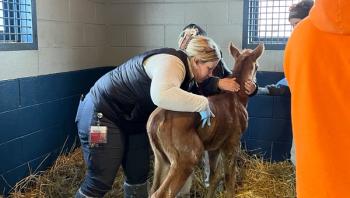
Answer C Image Quiz: A recurrent, painful ear infection
Answer C:Pseudomonas aeruginosa - Correct!
Pseudomonas aeruginosa is a common finding in ear infections unresponsive to treatment in dogs. Other gram-negative rod-shaped bacteria that can be detected in cases of otitis externa include Proteus species, Escherichia coli, and Klebsiella species; however, these bacterial species are often detected concurrently with other bacteria, specifically Staphylococcus pseudintermedius. It is important to note that only a bacterial culture would be able to distinguish which bacterial species are present.
Pseudomonas species is considered opportunistic bacteria, which overgrows in a diseased ear canal, often when normal flora has been inhibited by antimicrobial therapy.1 It is not a commensal bacterial inhabitant of the ear.2 Clinically, pseudomonal ear infections tend to produce copious amounts of purulent exudate, which demonstrate large bacilli and numerous leukocytes on cytologic examination. These patients often have marked erosion and ulceration detected along the ear canal walls, which can cause great pain.
Pseudomonas aeruginosa otitis can be very difficult to clear, and treatment of these infections may be frustrating for clients and veterinarians. These bacteria are often resistant to the commonly used topical and systemic antibiotics and easily acquire new resistance.3 Pseudomonas species exhibit the least antimicrobial resistance with aminoglycosides and fluoroquinolones.4, 5 Topical antibiotic therapy is often preferred because the antibiotic can be administered in a higher concentration with fewer systemic side effects.
Patients with Pseudomonas otitis externa also benefit from treatment with topical or systemic glucocorticoids, and sometimes both. Glucocorticoids have antipruritic and anti-inflammatory effects, and they decrease swelling and proliferative changes to promote drainage and improve ventilation of the ear. This helps improve the owner's ability to flush the ear and increases the pet's comfort.
Pseudomonas aeruginosa may also produce biofilms, which correlate with reduced topical antimicrobial efficacy. Thus irrigation and cleaning of the canals are imperative in these patients. A cleaning agent that includes Tris-EDTA is often used, as it can enhance or act synergistically with many topical antibiotics.6
Finally, the failure to respond to treatment in this case may imply a resistant strain of bacteria or a failure to identify and treat the primary cause of the otitis. Bacterial infection is considered a secondary cause, as it will create disease in the already abnormal ear. Allergies, foreign bodies and parasites are all potential primary triggers for ear disease. The ear infections will continue to return if the primary cause is not addressed.
REFERENCES
1. Palmeiro BS, Morris DO, Wiermelt SP, et al. Evaluation of outcome of otitis media after lavage of the tympanic bulla and long-term antimicrobial drug treatment in dogs: 44 cases (1998-2002). J Am Vet Med Assoc 2004;225:548-553.
2. Matsuda H, Tojo M, Fukui K, et al. The aerobic bacterial flora of the middle and external ears in normal dogs. J Small Anim Pract 1984;25:269-274.
3. Morris DO. Medical therapy of otitis externa and otitis media. Vet Clin North Am 2004;34: 541-555.
4. Hariharan H, Coles M, Poole D, et al. Update on antimicrobial susceptibility of bacterial isolates from canine and feline otitis externa. Can Vet J 2006;47:253-255.
5. Malayeri HZ, Jamshidi S, Salehi TZ. Identification and antimicrobial susceptibility patterns of bacteria causing otitis externa in dogs. Vet Res Commun 2010;34:435-444.
6. Farca AM, Piromalli G, Maffei F, et al. Potentiating effect of EDTA-Tris on the activity of antibiotics against resistant bacteria associated with otitis, dermatitis and cystitis. J Small Anim Pract 1997;38(6):243-245.
Newsletter
From exam room tips to practice management insights, get trusted veterinary news delivered straight to your inbox—subscribe to dvm360.






